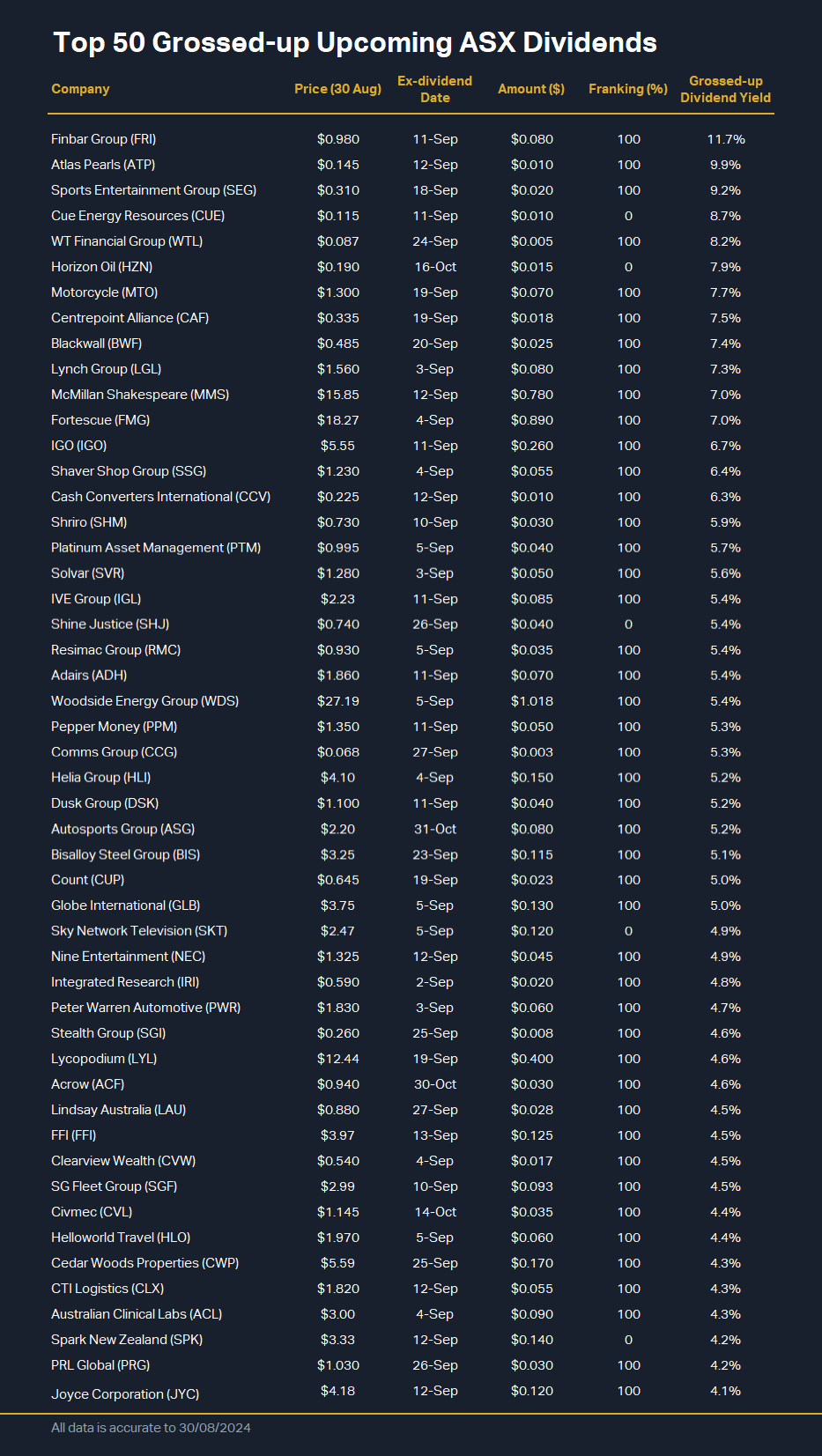How to get your slice of the $50 billion ASX dividend pie (and avoid the traps)
Last week, I provided a schedule of upcoming dividends based on the companies that had reported earnings and declared a dividend as we commenced the final week of FY24 earnings season. With all companies having now reported, this is an excellent opportunity to revise both the “Upcoming” and “Juiciest” dividends lists.
We’ll also review some of the key tax implications ASX dividend investors need to know about, as well as explain the concept of the “Dividend Trap” – something you'll want to pay particular attention to this dividend season.
Revised upcoming dividend schedule
ASX listed securities will pay out $39.1 billion in dividends between August and November as (for the most part), companies pay out their full year dividends. When franking credits are accounted for, this value rises to $52.4 billion.
Dividends are big business for Australian investors, and in many cases, they can make or break an investor’s total annual shareholder return. This is why our sister site Market Index maintains a comprehensive list of companies that are about to pay a dividend – at any time of the year. It’s worth bookmarking this page and checking up on it regularly to see which companies are about to go ex-dividend, by how much, and to what degree each dividend is franked.
For those who are new to dividends, we’ve used quite a bit of dividend jargon so far, and you might wish to check out this article for full explanations of all the key terms.
Revised Juiciest Top 50 Upcoming ASX Dividends list
What our Upcoming Dividends page doesn’t do, is show you which are the biggest dividends that are about to be paid sorted by dividend yield, particularly those that also provide the greatest franking credit benefits. For this data, you’ll need a little spreadsheet nous, but don’t fret – I’ve done the hard work for you. See below a table containing the Top 50 upcoming dividends based on grossed up dividend yield, that is, accounting for each dividend’s degree of franking.

Note, the dividend yields in the above table are based on the closing price of each security on Friday 30 August. Further, they are a standalone yield, meaning that previous dividends paid by each security within the last 12 months have not been considered. Also consider that not all shareholders may get the full benefit of franking credits, and therefore the full grossed-up dividend yield may not be applicable to them.
There are no free lunches in investing (or dividends)
There are a few important considerations for investors looking to capture Australian dividends. Firstly, a company’s share price will typically fall by the amount of the dividend plus the associated value of franking credits on the ex-dividend date. This means that usually, what an investor gains in a dividend payment, they lose on the capital value of their shareholding. There are no free lunches in investing!
So, why bother trying to capture large dividends at all? For many working investors, there’s not a huge difference between dividend income compared to if a company had retained the earnings and instead maintained a higher share price (therefore delivering potentially a higher capital return).
In fact, for these investors, they might be better suited to investing in companies that tend to retain their earnings with a view to growing future returns, rather than companies that pay out a big dividend to shareholders and therefore lose access to that capital.
High dividend yields, and particularly high and fully franked dividend yields, become particularly attractive for those investors who are on very low tax rates, and or those who require a stable and regular income stream – for example, self-funded retirees. For these investors, a high and fully franked dividend yield is likely far more useful and lucrative than the equivalent company profit retained as a capital gain.
$70 fully franked dividend in the hands of a taxpayer on a 37% marginal rate (e.g. a typical Australian worker whose income is $120,000-$135,000):
Taxable income: $100
Tax liability: -$37
Franking credit (30c in the dollar for fully franked dividend): +$30
Net tax liability: -$7
Total dividend benefit to shareholder: $93
$70 fully franked dividend in the hands of a taxpayer on a 15% marginal rate (e.g. a typical Australian self-funded retiree or most superannuation funds):
Taxable income: $100
Tax liability: -$15
Franking credit (30c in the dollar for fully franked dividend): +$30
Net tax liability: +$15
Total dividend benefit to shareholder: $115
$70 fully franked dividend in the hands of a taxpayer on a 0% marginal rate (e.g. an Australian retiree on certain qualifying annuity-style pension products):
Taxable income: $100
Tax liability: $0
Franking credit (30c in the dollar for fully franked dividend): +$30
Net tax liability: +$30
Total dividend benefit to shareholder: $130
Beware the Dividend Trap!
After a company goes ex-dividend, its share price fluctuates – as it always does –based on the company’s ongoing profitability. It is important to remember that there are no guarantees a company’s share price will recoup its dividend over time.
This means that what appears to be a fantastic dividend yield today, may not be maintained in the future. For this reason, it is generally better to buy a company that has strong earnings growth prospects – and is therefore more likely to be able to maintain and grow its dividend payments – instead of a company that is paying a high dividend today but cannot maintain that dividend in the future.
The term “Dividend Trap” refers to a dividend yield that appears to be very high based upon the last 12 months of dividends paid by a company. Consider how a company’s dividend yield is calculated: Dividend / Share Price. This means a high dividend will increase the dividend yield – but so too will a low share price.
A company’s share price might be low because the market believes its earnings growth prospects are very low. It is often a false economy to buy a stock that has a high dividend yield because its share price has fallen substantially. It is less likely that such a company will maintain its dividend, and therefore its dividend yield. In many cases, such a company will be forced to cut its dividend, resulting in a lower future dividend yield.
This is the Dividend Trap – the investor has purchased a company with poor earnings growth prospects, and its dividend is not maintained – so they end up with a company that delivers poor capital gains and a reduced dividend or no dividend at all.
The prospect of the Dividend Trap means that a basic scan of the market for high dividend yielding companies is potentially risky. It is usually better to scan for other metrics that are focussed on the quality of a company’s profitability and future earnings growth potential (for example, free cash flow metrics such as Price to Free Cash Flow, and earnings growth metrics such as PEG ratio).
Our resident expert on earnings growth-oriented factor scanning is Chris Conway. In our next article on the ASX dividend season, I’ll be asking Chris to share with us his approach to scanning the ASX for stocks that have the strongest earnings growth potential. For those of you who love to find juicy ASX dividends, the goal is to provide you with extra criteria that might help you hone your search results to only those stocks that have the best chance of maintaining them.
This article first appeared on Market Index on Monday 2 September 2024.
5 topics
25 stocks mentioned
1 contributor mentioned

